Reimagine Black Youth Mental Health

[ad_1]
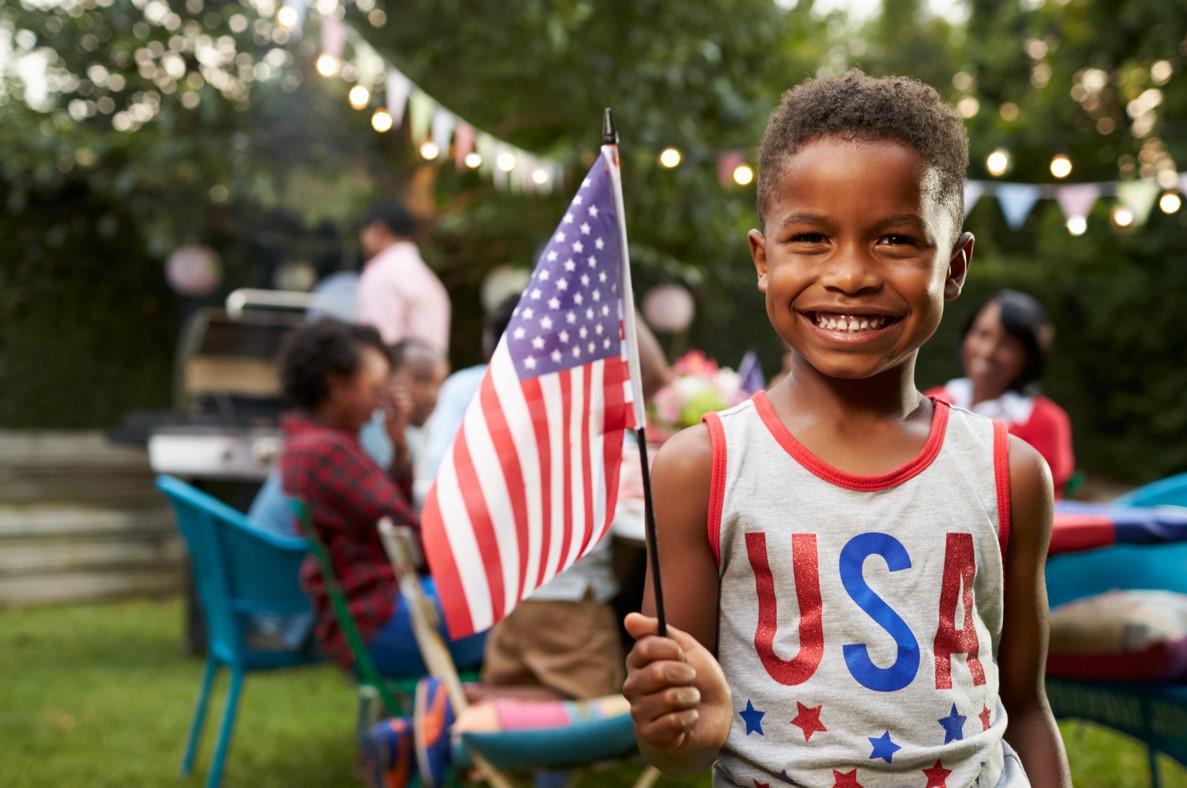
The Reimagine Black Youth Mental Health (RBYMH) initiative is about improving the mental well-being of Black youth and families in Minnesota and expanding the approach to mental health. This three-year policy demonstration project is supported by the U.S. Department of Health and Human Services Office of Minority Health grant.
Goals
Brooklyn Bridge Alliance for Youth (BBAY) is a joint-powers board between the Cities of Brooklyn Center and Brooklyn Park, Hennepin County, the school districts of Osseo, Brooklyn Center, Robbinsdale and Anoka-Hennepin, and the two community colleges of Hennepin Technical College and North Hennepin Community College.
The Minnesota Department of Health (MDH) partnered with the BBAY to establish a community and Black youth-led process with a shared set of goals:
Focus on Black Joy: Shift the narrative from deficit to well-being. This honors the diversity of the Black experience and celebrates Black identity and cultures.
Strengthen the ecosystem: Create the environments for Black youth to thrive, increasing resources and connections for organizations, families and communities.
Change the conditions that perpetuate harm: Change policies across community settings to address collective harms, instead of putting the burden solely on individuals. This lights a health in all policies approach to mental health.
Model community-driven change: Facilitate an authentic Black youth and community-led policy change process that models effective ways for Black youth to create change, building the capacity of individuals, families, and community.
The approach
Black centered: Support the variety of experiences Black youth have, including opportunities for mental well-being.
Youth led: Create a Black youth affinity space to define what mental health looks like and the crucial steps to claim positive racial identity and mental well-being.
Community driven: Create Black leader affinity spaces to discuss shared experiences, define the issue, and prioritize solutions.
Local/state partnership: Foster state and local partnerships to develop the wider cross-system communication to advance and sustain narrative shifts and policy change.
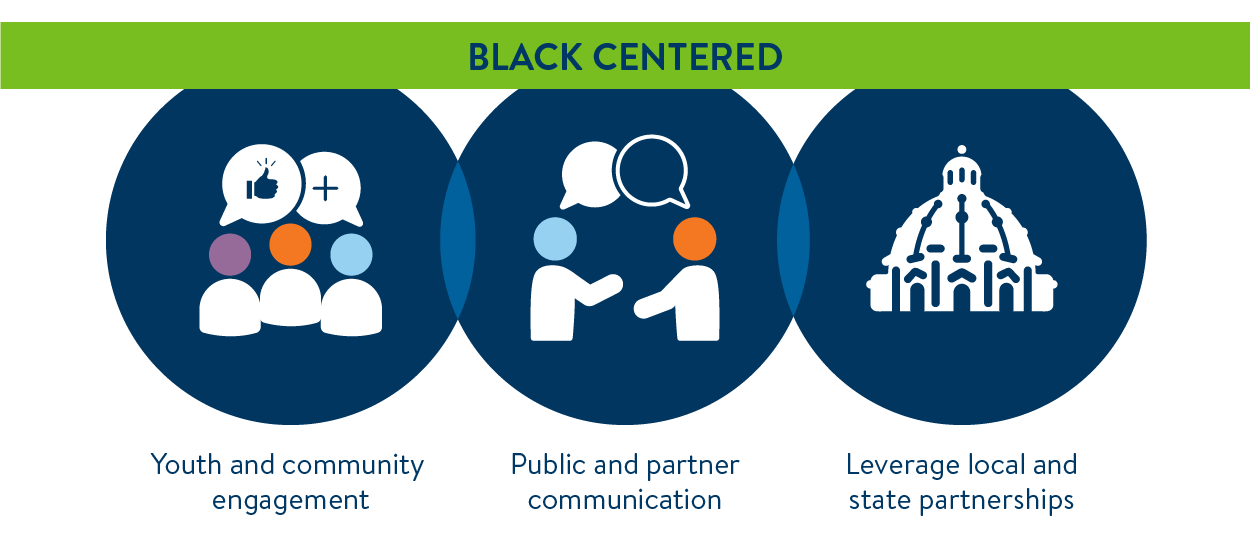
The Black youth affinity space and their experiences with sharing Black Joy and identity is proving to be foundational for supporting young Black leaders as they define what mental health looks like and the crucial steps on the road to claiming positive, racial identity and mental wellbeing.
- What we ask determines what we find.
- What we find determines how we talk.
- How we talk determines what we can imagine.
- What we can imagine determines what we achieve.
The Advisory Council’s approach:
- We won’t ignore trauma, grief, stress, other aspects of unwellness — especially as it is situated in the context of systemic and interpersonal racism.
- We will simultaneously illuminate health – what is good and working in Black lives, what gives hope and life, what must be acknowledged and watered.
- There is already greatness in all people and communities.
- Finding and studying that greatness can offer one pathway to solutions.
- Stories are a key source of insight.
Youth voices on Black Joy:
- “Having choices.”
- “Being able to choose.”
- “Being seen and understood by people.”
- “Supporting others.”
- “Being a part of the team.”
- “Being free.”
- “Being comfortable.”
- “Black success.”
Black youth in Minnesota
Black youth in Minnesota are at risk of experiencing toxic stress that contributes to depression and anxiety due to long-standing structural racism. While these impacts are not always felt directly by Black youth, these systemic inequities have resulted in negative, disproportionate outcomes for homeownership, income, incarceration, and physical and mental health in Black populations in Minnesota. This project will explore policies and practices to reimagine these realities for Black youth in the Brooklyns and for the rest of Minnesota.
Mental well-being in Black youth
Mental well-being is about having fulfilling relationships, utilizing strengths, contributing to community and being resilient, which is the ability to bounce back after setbacks. Mental well-being is a core ingredient for success in school, work, health, and community life. Many components are encompassed in mental well-being, including ten from the Minnesota Student Survey conducted every three years. Based on the 2022 Minnesota Student Survey data, non-Hispanic Black, African, or African American students (hereafter referred to as Black youth) reported lower rates for mental well-being components compared to their non-Hispanic white peers. The largest disparities in mental well-being components by race and ethnicity include social integration, social competency, personal growth, empowerment, and family/peer relationships. For more information on mental well-being components, please reach out to learn more.
Table 1. Non-Hispanic Black youth are less likely to report all mental well-being components when compared to non-Hispanic white youth
| Statewide MSS Mental Well-being | Non-Hispanic Black |
Non-Hispanic White |
% Point Difference |
All MN Youth |
|---|---|---|---|---|
| Family Relationships | 68% | 85% | 17% | 81% |
| Peer Relationships | 66% | 82% | 16% | 78% |
| Personal Growth | 56% | 69% | 13% | 65% |
| Social Integration | 46% | 65% | 19% | 59% |
| Educational Engagement | 58% | 58% | 0% | 58% |
| Student-Teacher Relationships | 40% | 48% | 8% | 46% |
| Empowerment | 36% | 48% | 12% | 44% |
| Social Competency | 32% | 46% | 14% | 41% |
| Community Relationships | 35% | 42% | 7% | 39% |
| Positive Identity | 27% | 31% | 4% | 28% |
Black youth in the Brooklyns
- The Brooklyns are two of the most diverse cities in the state.
- 10,414 Black youth (ages 10-17) across the diaspora in the Brooklyns.
Figures 1. Schools in Brooklyn Park and Brooklyn Center
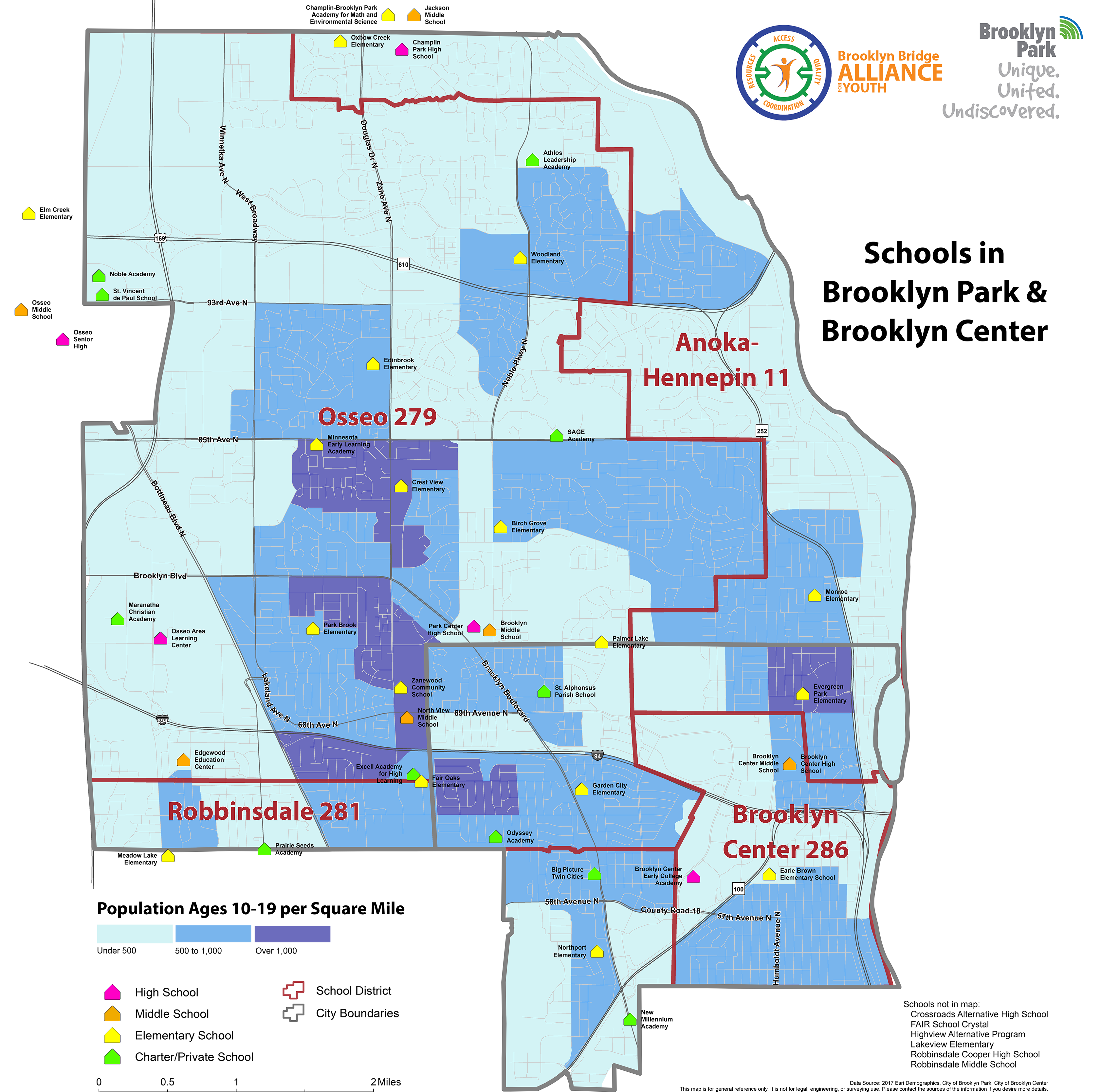
This community-driven process to Reimagine Black Youth Mental Health is in Brooklyn Park and Brooklyn Center, Minnesota. Collectively called the Brooklyns, Brooklyn Center and Brooklyn Park are the northwest suburbs of Minneapolis and are the two most diverse cities in the state. The total population in 2020 was 105,875, including 16,000 youth ages 10-19 years old. The combined population includes 51% BIPOC, including 27% Black (15% African American and 12% African). The four school districts that cover this area are Osseo Public Schools, Robbinsdale Public Schools, Brooklyn Center Public Schools, and Anoka-Hennepin Public Schools.
Brooklyn Center is the hometown of Daunte Wright, who was killed by Brooklyn Center police in April 2021, only eleven months after the police murder of George Floyd in neighboring Minneapolis.
All student reporting well-being components
Mental health has become a priority in nearly every county in Minnesota, according to the Community Health Assessment, and has been for many years.
- The share of community health boards that reported mental health as a priority health issue increased from 77% to 96% in 2020.
Mental well-being has been consistently decreasing since 2016 (see Figure X). Marginalized youth, such as those experiencing economic hardship, non-cis gender, LGBTQIA+, and youth of color, report lower levels of positive mental well-being. Positive identity has dropped more than 20 percentage points from 2016 to 2022.
Figure 2. All Positive Mental Well-Being Components dropped from 2016 to 2019 and again from 2019 to 2022
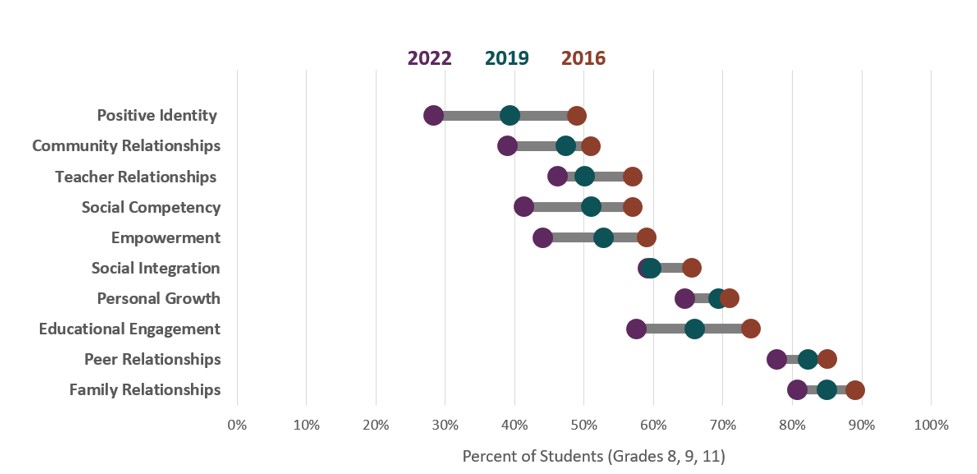
Data Source: Minnesota Student Survey, 2022
The more mental well-being components youth report, the better their health outcomes. One method to assess overall mental well-being, or whether Minnesota youth are thriving, is a simple cumulative score of the ten mental well-being components listed above. If youth report 8-10 mental well-being components, they are considered to have high positive mental well-being. There are differences among black youth in reporting high positive mental well-being.
Figure 3. High Positive Mental Well-Being within Black Youth
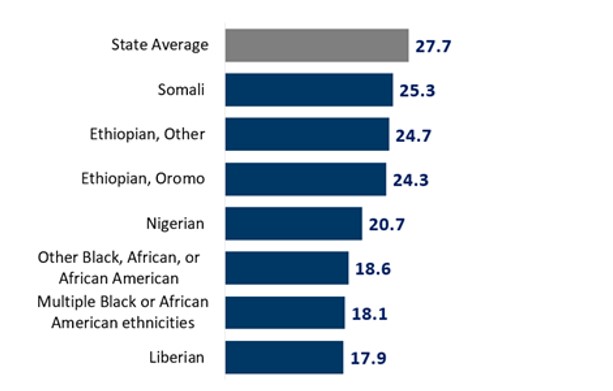
Data Source: Minnesota Student Survey, 2022
Health in all policies approach
Mental Health: a state of well-being in which the individual realizes his or her own abilities, can cope with the normal stresses of life, can work productively and fruitfully, and is able to make a contribution to his or her community. – World Health Organization
The health in all policies approach leverages the relationships between positive mental health and the many social factors that impact mental health, from education, parks, public recreation, to policing and more. These policy areas impact our health and mental health whether we are conscious of them or not. Ensuring policies enhance our mental well-being and elevate human dignity, respect, and growth; Black youth will have opportunities to better contribute to society and develop in a positive and healthy way. Policies that invest in the economic, social, and political environments will contribute to overall increased well-being for all.
Through this lens, the Advisory Council, in partnership with Black youth in the community, will identify and implement specific policies at the local level that are expected to have the greatest impact on BYMH. Under the leadership of the Advisory Council, the community will develop a process to engage Black Youth in identifying a range of policies that play a role in improving BYMH.
Youth voices on policy
Individuals and communities have different perspectives on what it means to be well. Youth and community-led discussions throughout 2023, coordinated by the Brooklyn Bridge Alliance for Youth, explored a wide range of critical elements for Black youth well-being. Topics included the nuances of the Black experience, the importance of establishing strong connections within the Black community, leveraging personal networks to drive positive change, the role of storytelling in relation to Black Joy, and others. Youth and community leaders chose the following areas to center deeper policy discussions:
- Safety
- Family
- Identity
- School
- Social media
Building community capacity and state/local partnership
Advisory Council
The Advisory Council was cultivated through individual stakeholder meetings, an initial public meeting with potential local system partners, and development of a draft charter; the council launches formally in January 2023. The council is comprised of individuals at various levels of leadership from the Hennepin County Public Health Department, City of Brooklyn Park, City of Brooklyn Center, Osseo Area schools, Brooklyn Center Community Schools, Anoka-Hennepin Schools, Robbinsdale Schools, North Hennepin Community College and Hennepin Technical College, and a range of community organizations including African Career Education & Resources, One 2 One Mentoring, and InTentions.
The Council also includes other key decisionmakers in the Black community such as parents, pastors, and most importantly, Black youth. They have spent most of the first year of this project building deep and wide relationships within the community to develop trust and respect in the community. Building community trust was an ESSENTIAL component of this project with the Black communities in Brooklyn Park and Brooklyn Center.
RBYMH Summit recap
Reimagine Black Youth Mental Health Summit (PDF)
Continuous engagement: An extended mobilizing phase that offers youth and families multiple opportunities to engage, build relationships, and explore this complex topic in a safe environment, is essential to get to the deep level of reflection needed.
Safety: Youth space focused a lot on building safety to have meaningful discussions about mental health. This critically informed a safe, engaging, and transformational youth summit.
Complexity: Mental health is a complex topic involving trauma, racial identity, history, and family history. Discussions must take place with care, patience, and humility.
Representation matters: There must be broad representation in participants and leadership from across the diaspora because the Black experience is diverse.
Mobilizing youth leadership: Active engagement of youth to inform and shape the community process is foundational.
Sharing power is a practice: Implementing power sharing in day-to-day operations can be challenging despite sharing this core value. It requires ongoing efforts to build trust, navigate relationships and decision making, outline roles and set boundaries between leadership bodies.
Black Youth Affinity Space
Although Black youth are actively participating in leadership spaces throughout this project, it became quickly apparent that it was essential and valuable for Black youth to have their own space. The Black Youth Space was launched in Spring 2022 to build community, explore identity and culture, and better understand mental health and wellbeing. The group meets every two weeks to build trust, relationships and shared experience with other Black people, and explore wellness. This youth space is critical for mobilizing and engaging Black youth who are taking on leadership roles in this initiative. One of the significant findings in this project was the need for this Black youth affinity space for young people to feel safe and heard.
State Resource Team
The State Resource teams provides the infrastructure to implement policies and practices that improve outcomes for Black youth mental health. MDH has established partnerships across the state enterprise that can help leverage additional resources, contacts, and research to support effective policy implementation, amplify and promote effective policies from the demonstration project, and support sustainability by incorporating aspects of the process into existing programs and providing vehicles for systematically scaling the policy implementation in other community settings.
The State Resource Team (SRT) is led and convened by MDH and includes the BBAY coordinator. MDH staff conducted 25 individual 1:1’s with various state partners to begin orientating them to the State Resource Team.
- Governor Walz’s Children’s Cabinet
- State Health Improvement Partnership (SHIP)
- Regional Equity Coordinators
- Suicide Prevention
- Minnesota School Based Health Centers (SBHC)
- Minnesota Department of Education
- Minnesota Office of Higher Education
- Minnesota Department of Human Services
- Center for Health Equity
- Minnesota Department of Public Safety
- Minnesota Department of Natural Resources
- Minnesota Association of Children’s Mental Health
Project background
Initiative Goals
The Reimagine Black Youth Mental Health Initiative has three goals:
- Improve Black youth mental health.
- Design a process that includes Black youth and communities in policy development.
- Implement a ‘mental health in all policies’ approach.
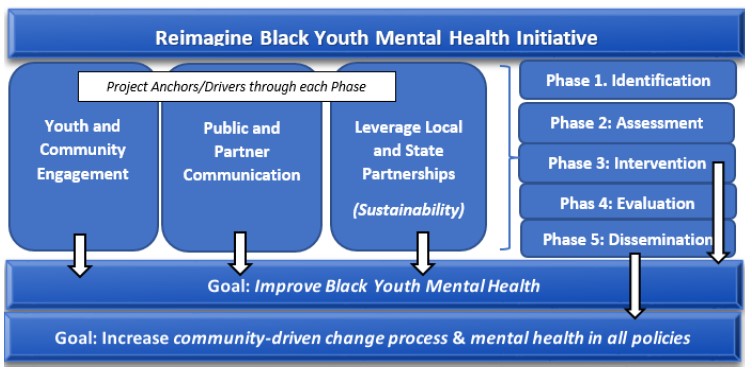
Defeating the myths of racism and colorism
Understanding the context of racism. Common beliefs are embedded into the cultural knowledge of many communities. Many of these pernicious and harmful myths are designed to instill fear and distrust, while contradicting the reality for diverse communities.
Throughout this project, community and system partners have reinforced that addressing systemic racism will not disrupt the market economy, will not harm white people, and will not undue American society as we know it.
Improving Black youth mental health will help enhance civil liberties for all, increase economic prosperity for everyone, and contribute to the increase in overall wellbeing for everyone. The great irony of racist ideas and systemic racism in Minnesota and in the U.S. is that it continues to undermine the legitimacy of democracy, capitalism, law and order, and prosperity for all.
By greater engagement in the political process and economic and social well-being for everyone, it will strengthen the overall system and allow for increased opportunity for people of every culture and ethnicity.
Historical context
Protective Communities for Black Children and Youth: A focus on mental health – Dr. Mavis Sanders
Reimage Black Youth Mental Health Event Presentation – Nov. 16, 2023 (PDF)
Mental well-being and racial justice
Mental well-being requires a sense of purpose and self-determination. To truly experience mental well-being, Black youth need to feel and have the power to shape their world and change their lives and conditions for the better. For many, historical trauma is a reality that disrupts a sense of purpose and power and continues to be part of lived experience and reality.
Systematic racism and generational structural inequities (social, economic, political, and environmental) result in poor health outcomes. These inequities have a greater influence on health outcomes than individual choices or one’s ability to access health care, and not all communities are impacted the same way. All people living in Minnesota when health disparities are reduced and racial equity is advanced.
Chronological activities and policies
As the State Resource Team started gathering, MDH highlighted the landscape of racial policies and the historical context that helped inform the process of identifying policies to improve Black youth mental health.
Reconstruction (1865-1877)
- South’s first state-funded public-school systems, more equitable taxation, laws against racial discrimination in public transport and accommodations and ambitious economic development programs.
- Civil Rights Act of 1875
Policies challenging racial groups (1877-1957)
- Electoral disenfranchisement
- Economic subjugation of Black People
Civil Rights Era (1957-present)
- Civil Rights Act 1957
- Civil Rights Act 1964
- Civil Rights Act of 1968
Local Policy History
- Interstate 94 – Rhondo community
- Earle Brown Heritage Center
- Racial covenants in housing, part of New Deal
- Recreation settings: Filling swimming holes with concrete
- Business Ownership in Minnesota in 2017
- White: 80% of population, 95% are white owned businesses
- Black: 6% of population, 1% are black owned businesses
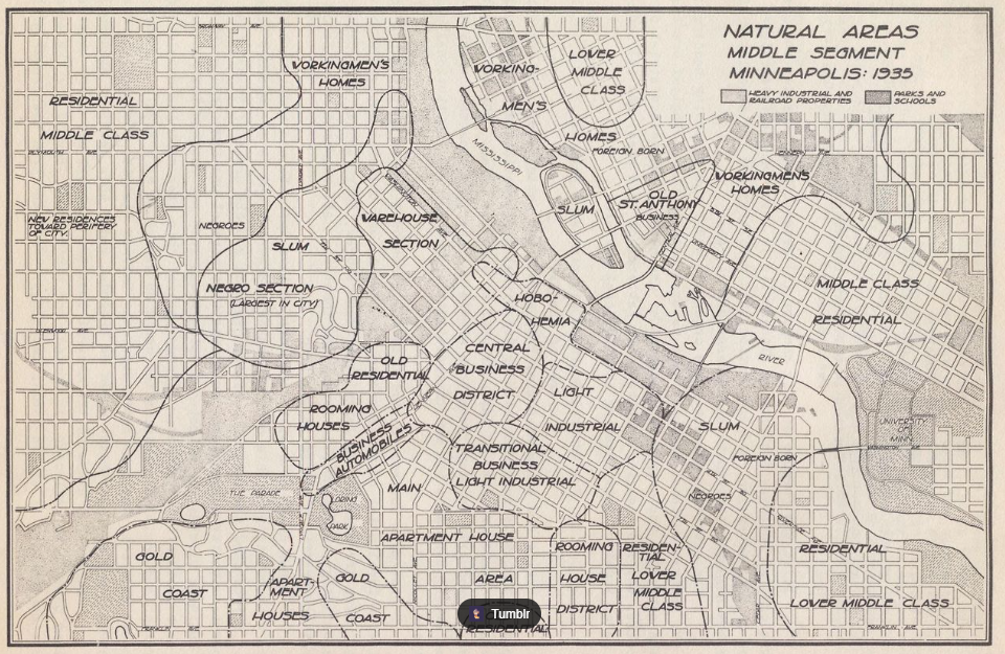
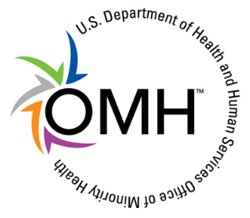
Mental health resources
More information on mental health
Questions
Email health.mch@state.mn.us or call 651-201-3650.
[ad_2]
Source link
